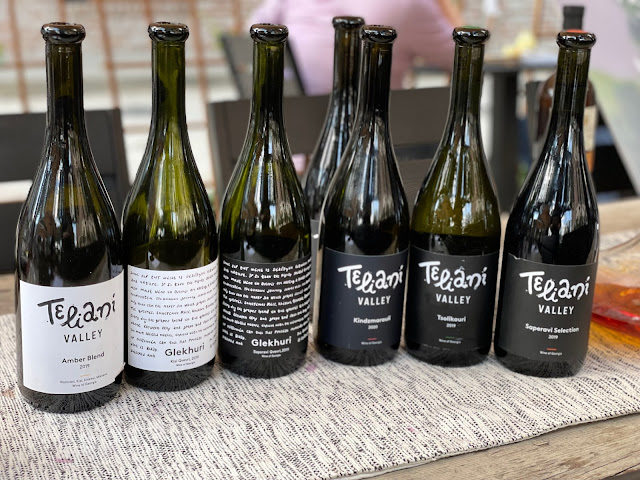
Last month, wine professionals in Houston were given the opportunity to taste wines from one of the country of Georgia's flagship producer, Teliani Valley, over lunch at Concura to learn about the ancestral grapes, the ancient winemaking techniques, and the modern tools which come together to make the classic wines of the Kakheti region. There are 525 grape varieties currently recorded in the country with over 135,000 acres under vine, 72.4% of those vines are located in Kakheti.
The country of Georgia is located approximately 620 miles from Rome and size wise, it is just slightly smaller than the state of Connecticut. Despite its small size, it has a lot of neighbors that border it: Armenia, Azerbaijan, Russia, and Turkey; it also touches the Black Sea. The Kakheti wine region is located in the eastern part of Georgia with two river basins, the Ivri and Alazani, which both influence the wines. The vineyards are located at elevations of 800 to 2,600 feet with views of the Caucasus Mountains. The dry seasons are the summer and winter with low annual rainfall overall due to the Likhi Ridge which divides Georgia. The soils of the Kakheti region are richly hued due to the high concentration of iron.
Georgians have made wine in vessels called Qvevri since the 6th millennium BC. These huge clay containers can be lined with beeswax and buried underground to maintain more constant temperatures while fermenting and macerating grapes. This process gives the white wines their famous amber or orange color and adds tannins to both the amber and red wines. A mini-sized version of the qvevri was passed around between the guests.In the Kakheti region, Rkatsiteli is the most important white grape while Saperavi is the most important red grape. These two indigenous grape varieties and this region were the focus of this tasting though we did try a couple of outliers.
Rkatsiteli is a versatile, frost resistant grape like Riesling and it can be made into different styles: conventional dry whites, amber via the qvevri method, sweet, and fortified. Common descriptors of this region's most elegant white include apple, citrus, and tropical fruit along with raw nuts and spice.
Saperavi is the main red grape and, like its white counterpart, it can be made into dry, sweet and fortified wines using both the ancient qvevri and more conventional methods of winemaking. Saperavi is in a unique group of red wine grapes known as teinturiers which have red pulp, most red wine grapes give the wines their color from their skins. Saperavi grapes create intense wines, both in color and character, with notes of cassis, dark fruit, licorice, coffee, and spice.
The Teliani Valley Winery was established in 1997 on the site of a former 19th century winery. The wines currently are the highest scoring Georgia wines on Wine Spectator offering a great quality to price ratio with a 2,000,000 bottle production. Dave McIntyre of The Washington Post called their conventional white, "delightful and refreshing." This winery may be a gateway to the wines of Georgia for wine inquisitive Americans.
The Tasting:
Tsolikouri 2019 - This dry, light body citrusy white was the refreshing wine that guests were greeted with upon arrival. This wine is made from Tsolikouri grapes that were fermented and aged in stainless steel with no skin maceration and these grapes were sourced from the Lechkhumi District in western Georgia. ABV 12%. SRP $14.
Flight 1 - Understanding Skin Contact
Amber Blend (Kakhuri No.8) 2019 - This wine is a blend of 40% Rkatsiteli, 40% Mtsvane, 10% Khikhvi, and 10% Kisi made in the dry, amber style using stainless steel for fermenting and aging with 6 months of skin maceration for the medium amber color, the soft yet firm texture, and the lingering spicy dried fruit finish. ABV 13%. SRP $17.
Wine People Kapanadze Rkatsiteli 2018 - Part of the Teliani Collection, this project is a limited collection of select wines from small producers to showcase wines made from rare and unique grapes. This wine is made from 80% Rkatsiteli blended with Aligote, Chinebuli, Mtsvane, and Mtsvivani grapes. A full body with noticeable tannins gives this qvevri made amber wine its color and style along with its notes of quince, pear, and honey. This wine was sourced from the Kartli Region which is located in Bolnisi, Georgia. ABV 13%. SRP $17.
Flight 2 - Saperavi in Many Incarnations
Saperavi 2020 - This 100% Saperavi wine is fermented and aged in stainless creating an easy drinking red with a black cherry/ berry profile, soft tannins, and a pleasant, lingering finish. ABV 13%. SRP $14.
Saperavi Selection 2019 - Sourced from a selected vineyard then fermented and aged in stainless steel, this full body, dry red is rich and intense with blackberry aromas and flavors, a refined tannic structure and a persistent finish. ABV 13%. SRP $20.99.
Glekhuri Saperavi Qvevri 2019 - This limited availability dry red is made from 100% Saperavi grapes in qvevri with 25% of stems left in during fermentation. Darkly colored with a bright red fruit character with fresh acidity and velvety tannins, complex and persistent. ABV 13.5%. SRP $24.
Kindzmarauli 2020 - This 100% Saperavi red is semi-sweet due to being sourced from the hotter Kindzmarauli District where grapes develop higher levels of sugar. The natural acidity combined with the natural residual sugar creates a very fresh and juicy fruit-driven wine with blueberry custard notes that Wine Enthusiast gave 90 points.
Flight 3 - Age-ability
Mukuzani Saperavi 2004 - Unique, complex, and unavailable but a true testament to the longevity.
Thank you to the hosts of this event, Teliani Valley, Georgian Wine House, Serendipity, and Yuri Bujar, for "making the world a little more Georgian".




Comments
Post a Comment
Thank you for reading Wine Life - Houston.